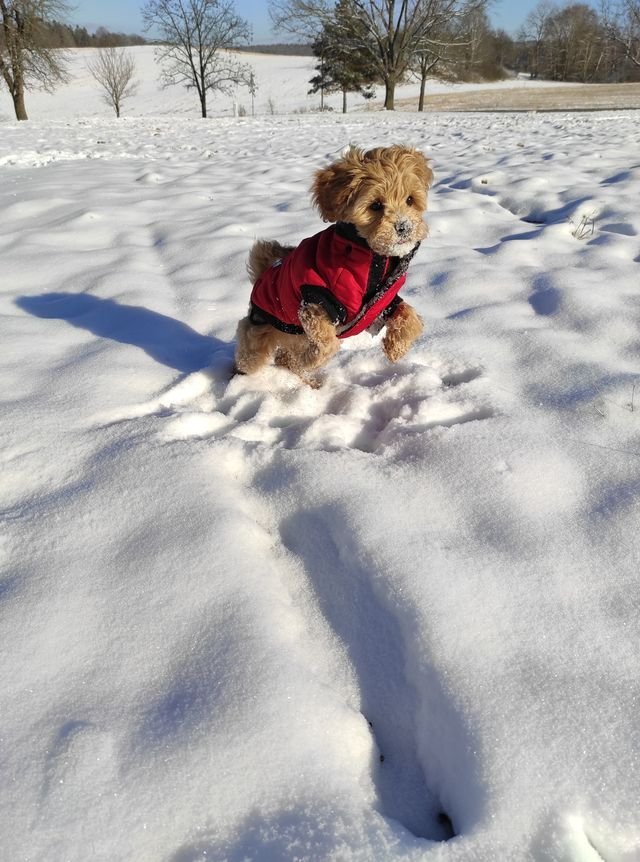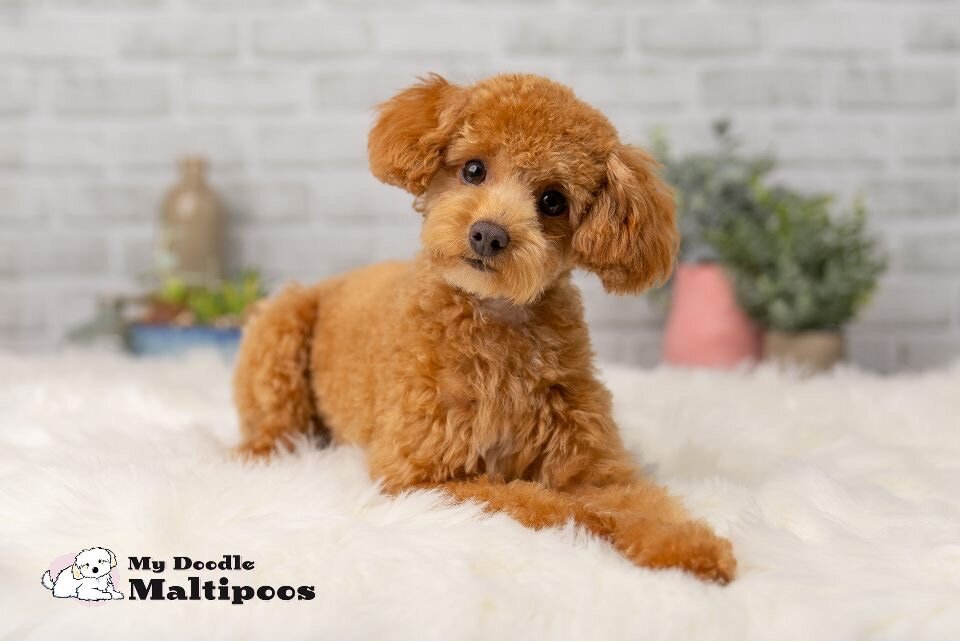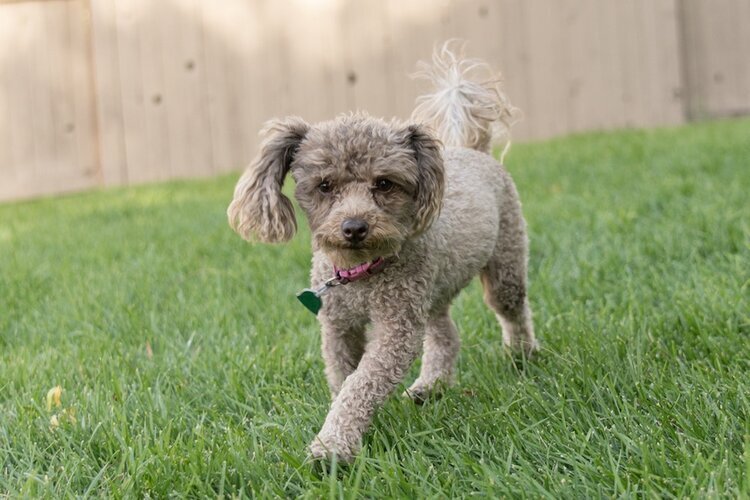Top 11 Care Tips For Your Maltipoo
It is exciting to have an adorable addition to the family with your new puppy, but parenting a new pup is no walk in the park. Below we will discuss how to properly care for your Maltipoo Puppy.
When the time comes to finally bring your new puppy home for the first time, you can pretty much count on three things: extra excitement, dealing with your puppy’s accidents, and a major lifestyle adjustment. As you’ll learn quickly, a growing puppy needs much more than a food bowl and a doghouse to thrive, and while it may be a lot of work initially, it’s well worth any effort. Establishing good and healthy habits in those first few sleep-deprived weeks will lay the foundation for many dog years of happiness for you and your puppy.
1. The First 2 Weeks
The initial two weeks after bringing your Maltipoo home are crucial for establishing routines, bonding, and starting basic training. Here's a guide to help you navigate this period:
Feeding Schedule: Puppies usually eat three to four times a day. Choose a high-quality puppy food suitable for small breeds and establish a consistent feeding schedule. Remember, it's vital to provide fresh water at all times.
Potty Training: Begin potty training immediately. Maltipoos are intelligent and can start learning to use a designated potty area quickly. Consistency is key. Take them to the designated area after meals, after waking up, and after playtime. Always reward successful potty outings with praise or treats to reinforce the behavior.
Sleeping Environment: Ensure your Maltipoo has a comfortable, quiet place to sleep. Many owners find that crate training is beneficial, as it provides a safe, cozy den for the puppy and aids in potty training. Place a soft bed in the crate and consider adding a blanket or a soft toy for added comfort.
Socialization and Play: Begin to gently introduce your Maltipoo to new sounds, sights, and experiences. Playtime is also important for bonding and burning off that puppy energy.
Vet Visit: Schedule your Maltipoo’s first vet visit within the first week of bringing your Maltipoo home. Your vet will check the puppy's health and discuss vaccination schedules, feeding, and care tips.
The first two weeks with your Maltipoo will be an exciting time of adjustment. Remember, patience, consistency, and lots of love will help your new puppy settle into their forever home.
2. Vaccinations and Medical Care
Your Maltipoo will need several vaccinations during its first year, and regular checkups thereafter. Be sure to ask your vet about the best vaccination schedule for your puppy. Remember, it's important not to double dose if the breeder has already administered any vaccines, as this can be harmful.
Common vaccinations for puppies include:
Distemper
Parvovirus
Hepatitis
Rabies
Also, discuss options for parasite control and spaying/neutering with your vet. It's important to start these health practices early to ensure your Maltipoo stays healthy.
3. Prepare for Your Puppy's Arrival with Essential Supplies
Your Maltipoo puppy will need a few basic items to start off its new life in your home:
Dog Crate: Most dogs don’t like to feel exposed and prefer cave-like spaces. Choose a crate that will be just bigger than your dog for them to feel safe in. This will be particularly useful for nighttime sleep and when you need to keep the puppy safe and secure. A crate like the Aspen Pet Porter Heavy-Duty Pet Carrier or the iCrate double-door dog crate is recommended.
Bed: A comfortable bed is a must for your Maltipoo. They will need a place to rest during the day, and a soft bed will make them feel comfortable and secure.
Snuggle Puppy: This is a plush toy that mimics the mother’s or littermate’s heartbeat to help your puppy feel safe, especially during the initial days when it might feel lonely or anxious.
Food & Water Bowls: Get food and water bowls that are the right size for your Maltipoo. The Vivaglory Dog Bowls Stainless Steel Water and Food Feeder is a good choice.
Collar/Harness & Leash: A good collar and leash are essential for those nice walks you'll be taking with your Maltipoo. The Barleygoo Bow Tie Dog Collar with Leash set is a suitable choice for smaller Maltipoos.
Booster Seat: A booster seat for your Maltipoo to sit in while in the car is also a good idea.
4. Find a Good Vet
The first place you and your new puppy should go together is the vet for a checkup. This visit will not only help ensure that your puppy is healthy and free of serious health issues, birth defects, etc., but it will help you take the first steps toward a good preventive health routine. If you don’t have or know a good vet, check with your friends for recommendations. You can also check with shelters to see if they have recommendations.
5. Prepare for Your Puppy's First Vet Visit
Your puppy's first vet visit can be stressful for both of you. Try to make this experience as positive as possible by following these tips:
Bring a favorite toy or blanket to help your puppy feel secure.
Don't feed your puppy right before the visit to prevent car sickness.
Speak in a calm, soothing voice to reassure your puppy during the exam.
Ask your vet if you can bring treats to reward your puppy after the exam.
6. Shop for Quality Food
Your puppy’s body is growing in critical ways which is why you’ll need to select a food that’s formulated especially for puppies as opposed to adult dogs. Look for a statement from the Association of American Feed Control Officials (AAFCO) on the packaging so you know that the food you choose will meet your pup’s nutritional requirements.
Small and medium-sized breeds can make the leap to adult dog food between 9 and 12 months of age. Large breed dogs should stick with puppy kibbles until they reach 2 years old. Make sure your puppy has fresh and plenty of water at all times.
What Food Do Maltipoos Eat?
Maltipoos thrive on a balanced diet that includes proteins, carbohydrates, fats, vitamins, and minerals. Lifes-Abundance Small and Medium Breed dog food is a popular choice for Maltipoos due to its nutrient-rich, holistic recipe formulated specifically for smaller breeds. It includes premium proteins and a unique blend of wholesome vegetables and fruits to provide the balanced, complete nutrition that is crucial to the health and well-being of your Maltipoo.
Feed your Maltipoo multiple times a day:
Age 6-12 weeks – 4 meals per day
Age 3-6 months – 3 meals per day
Age 6-12 months – 2 meals per day
7. Establish a Bathroom Routine
House training quickly becomes a high priority on most puppy owners’ list of must-learn tricks. According to the experts, your most potent allies in house training your puppy are patience, planning, and plenty of positive reinforcement. In addition, it’s probably not a bad idea to consider disinfectant and carpet cleaning plan because accidents will happen.
Until your puppy has had all of her vaccinations, you’ll want to keep them away from other animals. This helps reduce the spread of viruses and diseases. Make sure to give lots of positive reinforcement whenever your puppy manages to potty outside and, refrain from punishing her when she does have accidents indoors.
Knowing when to take your puppy out is almost as important as giving her praise whenever she does eliminate outdoors. Here’s a list of the most common times to take your puppy out to potty.
When you wake up.
Right before bedtime.
Immediately after your puppy eats or drinks a lot of water.
When your puppy wakes up from a nap.
During and after physical activity.
8. Watch For Early Signs of Illness
For the first few months, puppies are more susceptible to sudden bouts of illnesses that can be serious if not caught in the early stages. If you notice any of the following symptoms in your puppy, it’s time to contact the vet.
Lack of appetite
Poor weight gain
vomiting
Swollen of painful abdomen
Lethargy (tiredness)
Diarrhea
Difficulty breathing
Wheezing or coughing
Pale gums
Swollen, red eyes or eye discharge
Nasal discharge
Inability to pass urine or stool
Do Maltipoos get sick easily?
While Maltipoos, like any breed, can face health challenges, it's not accurate to say they get sick easily. They inherit potential health issues from both Maltese and Poodle parents, though these risks may be less pronounced than in purebred dogs due to hybrid vigor. Despite their small size, not all health problems they encounter are major; many are manageable with regular care. It's crucial for Maltipoo owners to schedule regular veterinary check-ups, ensuring early detection and effective management of any health concerns. Moreover, a balanced diet, regular exercise, and mental stimulation contribute significantly to their overall well-being. Hence, although Maltipoos might be predisposed to certain conditions, a responsible approach to their health can prevent them from frequently falling ill.
9. Teach Obedience
By teaching your puppy good habits, you’ll set your puppy up for a life of positive social interaction. In addition, obedience training will help maintain a stronger bond between you and your puppy.
Teaching your pup to obey commands such as sit, stay, down, and come will not only impress your friends, but these commands will help keep your dog safe and under control in any dangerous or potentially hazardous situations. Many puppy owners find that obedience classes are a great way to train both owner and dog. Trained professionals will usually accept puppies at age 4 to 6 months.
Tip: Keep it positive. Positive reinforcement, such as small treats, has been proven to be vastly more effective than punishment.
10. Be Sociable
It is equally as important to train for proper socialization as it is for obedience during puppyhood and will help avoid problems down the road. At about the age of 2 to 4 months of age, most puppies will begin to accept other animals, people, places, and experiences. Socialization training is an excellent way to keep positive experiences with your puppy. Be sure to ask your vet about what kinds of interaction is OK at this stage.
11. Grooming Essentials for Your Beloved Maltipoo
Caring for your Maltipoo's coat is an essential aspect of their overall well-being, given their lineage from breeds known for their grooming needs. To ensure their coat remains healthy, free from mats, and infection-free, a consistent grooming routine is paramount. Organizing a professional grooming session every four to six weeks is highly recommended; this not only keeps their coat trimmed and tidy but also contributes to their overall health. However, grooming isn't limited to professional sessions. Everyday care such as brushing their coat daily helps prevent tangles, and regular baths keep their skin clean and healthy. Additionally, an essential part of your Maltipoo's grooming routine should include regular ear checks to avoid infections, nail trimming for their comfort and mobility, and teeth cleaning to maintain oral health. Remember, grooming is not just about aesthetics—it significantly impacts your Maltipoo's health and happiness.
Are Maltipoos high maintenance?
Yes, Maltipoos are generally considered high maintenance when it comes to their grooming needs. They require daily brushing to keep their coats free from matting and debris. Often, Maltipoo owners opt for clipping their pet's coat to maintain a neat appearance and ensure comfort, especially during warmer months. While the full-body clipping usually needs to be done only once or twice a year, their facial hair may require monthly trims to keep it tidy. Moreover, Maltipoos typically need a bath at least once a month to keep their coats soft, clean, and healthy. This frequent grooming routine ensures your Maltipoo looks its best and helps prevent skin conditions and other health problems.














